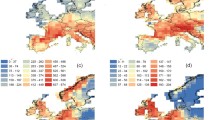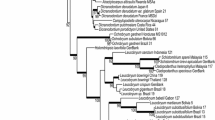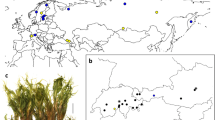Abstract
The extreme conditions of life in Antarctica pose challenges to many organisms. Bryophytes comprise the main vegetation of the continent and they endure many adversities, thriving in an environment hostile to most living organisms. Mosses are known to exhibit phenotypic plasticity, due to genotypic heterogeneity, environmental influences, or a combination of both. We investigated morphological diversity and its possible relationship with genetic diversity in the Antarctic moss, Roaldia revoluta, and also if the geographic distribution of morphotypes was related with environmental variables. We obtained 49 samples from Antarctica, including King George Island (K), James Ross Island (J), and several locations in the Antarctic Peninsula (P), representing most of the habitats where this species is found. A principal component analysis (PCA) was performed using quantitative measures of gametophytic morphological characters. For molecular analyses, we used DNA sequences of five molecular markers obtained from 29 specimens. Canonical correspondence analysis (CCA) was carried out to compare morphological diversity with environmental variables. Our data support the existence of two morphotypes of R. revoluta, morphotype A (apiculate and ovate leaves), more frequent in K, and morphotype B (acuminate and more oblong leaves), more common in J. Both morphotypes were present in P. The distinct morphotypes could not be related with genetic heterogeneity, since no sequence differences were found in any of the selected markers, supporting the morphological distinction being explained by environmental factors. The results from CCA supported a relationship between the observed morphological variation and the local environmental characteristics of wind speed and minimum temperature.








Similar content being viewed by others
References
Anderson LE (1954) Hoyer's solution as a rapid permanent mounting medium for bryophytes. Bryologist 57:242–244
Ando H (1973) Studies on the genus Hypnum Hedw (II). J Sci Hiroshima Univ Ser B 14:165–207
Ando H, Matteri CE (1982) Patagonian bryophytes. 7. Hypnum revolutum (Mitt.) Lindb. new to South America, with notes on the Hypnum species known from the Transecta zone, S Argentina. Lindbergia 8:60–64
Arikawa, T, Tsubota H, Deguchi H, Nishimura N, Higuchi M (2008) Phylogenetic analysis of the family Hypnaceae based on rbeL gene sequences. In: Mohamed L-L, Baki BB, Nasrulhaq-Boyee A, Lee PKY (eds) Bryology in the new millenniuln. University of Malaya, Kuala Lumpur, pp 215–225
Aristarain AJ, Pinglot JF, Pourchet M (1987) Accumulation and temperature measurements on the James Ross Island ice caps Antarctic Peninsula, Antarctica. J Glaciol 33:357–362
Amorim ET, Carvalho FA, Santos ND, Luizi-Ponzo AP (2017) Distribution of bryophytes in south-eastern Brazil: an approach on floristic similarity and environmental filtering. Cryptogamie, Bryol 38:3–17
Bell NE, Newton AE (2004) Systematic studies of non-hypnalean pleurocarps: establishing a phylogenetic framework for investigating the origins of pleurocarpy. Monogr Syst Bot Missouri Bot Gard 98:290–319
Biersma EM, Jackson JA, Hyvönen J, Koskinen S, Linse H, Griffiths K, Convey P (2017) Global geographical patterns in bipolar moss species. R Soc Open Sci. https://doi.org/10.1098/rsos.170147
Biersma EM, Jackson JA, Bracegirdle TJ, Griffiths H, Linse K, Convey P (2018a) Low genetic variation between South American and Antarctic populations of the bank-forming moss Chorisodontium aciphyllum (Dicranaceae). Polar Biol. https://doi.org/10.1007/s00300-017-2221-1
Biersma EM, Jackson JA, Stech M, Griffiths H, Linse K, Convey P (2018b) Molecular data suggest long-term in situ Antarctic persistence within Antarctica’s moss speciose plant genus, Schistidium. Ecol Evol. https://doi.org/10.3389/fevo.2018.00077
Biomatters (2010) Geneious v5.3.6. https://www.geneious.com. Accessed 29 May 2017
Borcard D, Gillet F, Legendre P (2011) Numerical Ecology with R. Springer, New York
Buck WR (1998) Pleurocarpous mosses of the West Indies. Memoirs of the New York Botanical Garden, 82, New York
Buck WR, Goffinet B, Shaw AJ (2000) Testing morphological concepts of orders of pleurocarpous mosses (Bryophyta) using phylogenetic reconstructions based on trnL-trnF and rps4 sequences. Mol Phylogenet Evol 16:180–198
Buryová B, Shaw AJ (2005) Phenotypic plasticity in Philonotis fontana (Bryopsida: Bartramiaceae). J Bryol 27:13–22
Câmara PEAS, Shaw J (2013) A molecular phylogeny of the moss genus Taxithelium (Pylaisiadelphaceae) based on plastid, mitochondrial and nuclear markers. Syst Bot 38:861–868
Câmara PEAS, Carvalho-Silva M, Henriques DK, Poveda DR, Gallego MT, Stech M (2018) Pylaisiaceae Schimp. (Bryophyta) revisited. J Bryol 40:251–264
Carvalho-Silva M, Stech M, Soares-Silva LH, Buck WR, Wickett NJ, Liu Y, Câmara PEAS (2017) A molecular phylogeny of the Sematophyllaceae s.l. (Hypnales) based on plastid, mitochondrial and nuclear markers, and its taxonomic implications. Taxon 66:811–831
Cox CJ, Goffinet B, Wickett NJ, Boles SB, Shaw AJ (2010) Moss diversity: a molecular phylogenetic analysis of genera. Phytotaxa 9:175–195
Davies BJ, Glasser NF, Carrivick JL, Hambrey MJ, Smellie JL, Nývlt D (2013) Landscape evolution and ice-sheet behaviour in a semi-arid polar environment: James Ross Island, NE Antarctic Peninsula. In: Hambrey MJ, Barker PF, Barrett PJ, Bowman V, Davies B, Smellie JL, Tranter M (eds) Antarctic palaeoenvironments and earth-surface processes. Geological Society of London, London, pp 353–395
Doyle JJ, Doyle JL (1987) A rapid isolation procedure for small quantities of fresh leaf tissue. Phytochem Bull 19:11–15
Fick SE, Hijmans RJ (2017) Worldclim 2: New 1-km spatial resolution climate surfaces for global land areas. Int J Climatol 37:4302–4315
Gardiner A, Ignatov M, Huttunen S, Troitsky A (2005) On resurrection of the families Pseudoleskeaceae Schimp. and Pylaisiaceae Schimp. (Musci, Hypnales). Taxon 54:651–663
Glime JM (2017) Introduction. 1: 1–10. In: Glime JM (ed) Bryoph. Ecol, vol 1. Physiol. Ecol. Ebook sponsored by Michigan Technological University and the International Association of Bryologists
Goffinet B, Cox CJ, Shaw AJ, Hedderson TA (2001) The Bryophyta (mosses): systematic and evolutionary inferences from an rps4 gene (cpDNA) phylogeny. Ann Bot 87:191–208
Hammer O, Harper DAT, Ryan PD (2001) Past: paleontological statistics software package for education and data analysis. Palaeontol Electron 4:1–9
Hedenäs L (2012) Global phylogeography in Sanionia uncinata (Amblystegiaceae: Bryophyta). Bot J Linn Soc 168:19–42
Hernandez-Maqueda R, Quandt D, Werner O, Muñoz J (2008) Phylogenetic relationships and generic classification of the Grimmiaceae. Mol Phylogenet Evol 46:863–877
Hedenäs L, Désamoré A, Laenen B, Papp B, Quandt D, González-Mancebo JM, Patiño J, Vanderpoorten A, Stech M (2014) Three species for the price of one within the moss Homalothecium sericeum s.l. Taxon 63:249–257
Higgins DG, Sharp PM (1988) CLUSTAL: a package for performing multiple sequence alignment on a microcomputer. Gene 73:237–244
Huttunen S, Bell N, Bobrova VK, Buchbender V, Buck WR, Cox CJ, Goffinet B, Hedenäs L, Ho B-C, Ignatov MS, Krug M, Kuznetsova O, Milyutina IA, Newton A, Olsson S, Pokorny L, Shaw JA, Stech M, Troitsky A, Vanderpoorten A, Quandt D (2012) Disentangling knots of rapid evolution: origin and diversification of the moss order Hypnales. J Bryol 34:187–211
Kato K, Arikawa T, Imura S, Kanda H (2013) Molecular identification and phylogeny of an aquatic moss species in Antarctic lakes. Polar Biol 36:1557–1568
Láska K, Budík L, Budíková M, Prošek P (2011) Method of estimating solar UV radiation in high-latitude locations based on satellite ozone retrieval with an improved algorithm. Int J Remote Sens 32:3165–3177
Legendre P, Gallagher ED (2001) Ecologically meaningful transformations for ordination of species data. Oecologia 129:271–280
Legendre P, Legendre L (2012) Numerical ecology. Elsevier Science, Amsterdam
McDaniel SF, Shaw AJ (2003) Phylogeographic structure and cryptic speciation in the trans-Antarctic moss Pyrrhobryum mnioides. Evolution 57:205–215
Medina NG, Albertos B, Lara F, Mazimpaka V, Garilleti R, Draper D, Hortal J (2014) Species richness of epiphytic bryophytes: drivers across scales on the edge of the Mediterranean. Ecography 37:80–93
Medina RG, Barcellos SA, Victoria FDC, Albuquerque MPD, Pereira AB, Stefenon VM (2015) Evidence of morphometric differentiation among Antarctic moss populations as a response to local microenvironment. Acta Bot. Bras. 29:383–390
Müller K, Quandt D, Müller J, Neinhuis C (2006) PhyDE®: phylogenetic data editor. www.phyde.de. Accessed 29 May 2017
Norris DH (1990) Bryophytes in perennially moist forests of Papua New Guinea: ecological orientation and predictions of disturbance effects. Bot J Linn Soc 104:281–291
Ochyra R, Smith RIL, Bednarek-Ochyra H (2008) The illustrated moss flora of Antarctica. Cambridge University Press, Cambridge
Oksanen J, Blanchet FG, Friendly M, Kindt R,Legendre, P McGlinn D Minchin PR, O'Hara RB, Simpson GL, Solymos P, Stevens MHH, Szoecs E, Wagner H (2016) Vegan: Community Ecology Package. R package version 2.4-0. https://CRAN.R-project.org/package=vegan
Olsson S, Enroth J, Buchbender V, Hedenäs L, Huttunen S, Quandt D (2011) Neckera and Thamnobryum (Neckeraceae, Bryopsida): Paraphyletic assemblages. Taxon 60:36–50
Øvstedal DO, Smith RIL (2001) Lichens of Antarctica and South Georgia: a guide to their identification and ecology. Cambridge University Press, Cambridge
Palmer MW (1993) Putting things in even better order: the advantages of canonical correspondence analysis. Ecology 74:2215–2230
Pereira MR, CdeS Dambros, Zartman CE (2013) Will the real Syrrhopodon leprieurii please stand up? The influence of topography and distance on phenotypic variation in a widespread Neotropical moss. Bryologist 116:58–64
Pisa S, Werner O, Vanderpoorten A, Magdy M, Ros RM (2013) Elevational patterns of genetic variation in the cosmopolitan moss Bryum argenteum (Bryaceae). Am J Bot 100:2000–2008
Quantum Gis Development Team (2017) Quantum GIS Geographic Information System. Open Source Geospatial Foundation Project
R Core Team (2017) R: a language and environment for statistical computing. Austria, Vienna
Reynolds LA, McLetchie DN (2011) Short distances between extreme microhabitats do not result in ecotypes in Syntrichia caninervis. J Bryol 33:148–153
Shaw AJ, Cox CJ, Goffinet B, Buck WR, Boles SB (2003) Phylogenetic evidence of a rapid radiation of pleurocarpous mosses (Bryophyta). Evolution 57:2226–2241
Simões JC, Bremer UF, Aquino FE, Ferron FE (1999) Morphology and variations of glacial drainage basins in the King George Island ice field Antarctica. Ann Glaciol 29:220–224
Smith RIL (1988) Bryophyte oases in ablation valleys on Alexander Island Antarctica. Bryologist 91:45–50
Spagnuolo V, Terracciano S, Cobianchi R, Giordano S (2008) Taxonomy of the Hypnum cupressiforme complex in Italy based on ITS and trnL sequences and ISSR markers. J Bryol 30:283–289
Stech M, Sim-Sim M, Esquivel G, Fontinha S, Tangney R, Lobo C, Gabriel R, Quandt D (2008) Explaining the ‘anomalous’ distribution of Echinodium (Bryopsida: Echinodiaceae): Independent evolution in Macaronesia and Australasia. Org Divers Evol 8:282–292
Taberlet P, Gielly L, Pautou G, Bouvet J (1991) Universal primers for amplification of three non-coding regions of chloroplast DNA. Plant Mol Biol 17:1105–1109
Tsubota H, Arikawa T, Akiyama H, Luna ED, Gonzalez D, Higuchi M, Deguchi H (2002) Molecular phylogeny of hypnobryalean mosses as inferred from a large-scale dataset of chloroplast rbcL, with special reference to the Hypnaceae and possibly related families. Hikobia 13:645–665
Turner J, Colwell SR, Marshall GJ, Lachlan-Cope TA, Carleton AM, Jones PD, Lagun V, Reid PA, Iagovkina S (2005) Antarctic climate change during the last 50 years. Int J Climatol 25:279–294
Turner J, Lu H, White I, Phillips T, Hosking JS, Bracegirdle TJ, Marshall G, Mulvaney R, Deb P (2016) Absence of 21st century warming on Antarctic Peninsula consistent with natural variability. Nature 535:411–415
Vanderpoorten A, Goffinet B (2009) Introduction to Bryophytes. Cambridge University Press, Cambridge
Yu J, Tang Y-X, Guo S-L (2012) Comparison of the geographical distribution of Racomitrium and Grimmia in China using ArcGis and MaxEnt software. Plant Sci J 30:443–458
Acknowledgements
We are very grateful to the Brazilian Navy, Brazilian Air force, Chinese Great Wall Station staff (King George Island) for their support during the austral summer 2016/2017, and to the Chilean Antarctic Institute (INACH) and its staff at Escudero station. We also thank the curators of the cited herbaria. This study was carried out with the support and under the auspices of the Brazilian Antarctic Program (PROANTAR). Funds were provided by National Advice for Scientific and Technological Development (CNPq) and Ministry of Science, Technology and Innovation (MCTI), whom we especially thank. P. Convey is supported by NERC core funding to the BAS ‘Biodiversity, Evolution and Adaptation’ Team.
Author information
Authors and Affiliations
Corresponding author
Ethics declarations
Conflict of interest
The authors declare that they have no conflicts of interest.
Electronic supplementary material
Below is the link to the electronic supplementary material.
Rights and permissions
About this article
Cite this article
Câmara, P.E.A.S., Valente, D.V., de Amorim, E.T. et al. Integrated analysis of intraspecific diversity in the bipolar moss Roaldia revoluta (Mitt.) P.E.A.S. Câmara & M. Carvalho-Silva (Bryophyta) in Antarctica. Polar Biol 42, 485–496 (2019). https://doi.org/10.1007/s00300-018-2437-8
Received:
Revised:
Accepted:
Published:
Issue Date:
DOI: https://doi.org/10.1007/s00300-018-2437-8




